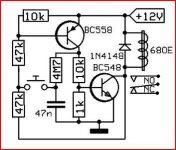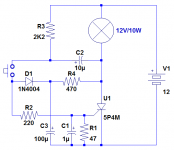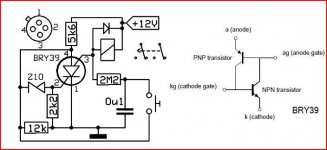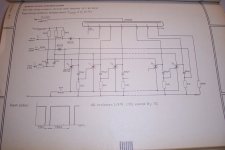Hi guys.
I'm looking to power on my 2x15W JLH from a physical on/off switch in the back and a one-touch button on the front. I want the touch button to turn on the amplifier when I first press it, and turn it off when I press it again.
This is what I've found so far, from eevblog...
https://imageshack.com/i/p9BJywFXj
However, this needs two different touch-buttons, which is both unpractical and uncool. In my head, this modification makes sense and will work, but will it?
https://imageshack.com/i/p3q0gmj5j
I've forgotten enough about electronics, I cannot figure out this myself, therefore I'm turning to you guys, perhaps this can help others as well. 😊
If this is a dead-end, please enlighten me, how can I easily make a simple on/off switch from one impulse switch/touch button. Got relays, bd139/140's, got diodes, caps, resistors... Just doesn't have any dedicated chips or 555's or whatever...
PS: tried to upload the images here first, but was missing a security token of some sort...
Sincerely grateful...
Ben from Norway.
I'm looking to power on my 2x15W JLH from a physical on/off switch in the back and a one-touch button on the front. I want the touch button to turn on the amplifier when I first press it, and turn it off when I press it again.
This is what I've found so far, from eevblog...
https://imageshack.com/i/p9BJywFXj
However, this needs two different touch-buttons, which is both unpractical and uncool. In my head, this modification makes sense and will work, but will it?
https://imageshack.com/i/p3q0gmj5j
I've forgotten enough about electronics, I cannot figure out this myself, therefore I'm turning to you guys, perhaps this can help others as well. 😊
If this is a dead-end, please enlighten me, how can I easily make a simple on/off switch from one impulse switch/touch button. Got relays, bd139/140's, got diodes, caps, resistors... Just doesn't have any dedicated chips or 555's or whatever...
PS: tried to upload the images here first, but was missing a security token of some sort...
Sincerely grateful...
Ben from Norway.
Hi guys.
I'm looking to power on my 2x15W JLH from a physical on/off switch in the back and a one-touch button on the front.
I want the touch button to turn on the amplifier when I first press it, and turn it off when I press it again.
You could use a latching relay that changes state when there is an input. Here's more info.
https://en.wikipedia.org/wiki/Relay#Latching_relay
Last edited:
Here are a couple of possibilities:
Latching power switch uses momentary pushbutton | EDN
I've made myself the one from figure 2 in the above link and it works without problems.
If you opt for a ready made PCB look at amb's offer below
The epsilon 24 power switch driver circuit
It is similar to the first circuit but has an option for thermal shut down...
Regards,
Oleg
Latching power switch uses momentary pushbutton | EDN
I've made myself the one from figure 2 in the above link and it works without problems.
If you opt for a ready made PCB look at amb's offer below
The epsilon 24 power switch driver circuit
It is similar to the first circuit but has an option for thermal shut down...
Regards,
Oleg
Post #13 here using a single 4013 CMOS chip. Its drawn as positive earth but the operation of the circuit is unchanged. You could use this to power a relay and arrange a simple constant voltage PSU for the CMOS chip (small 9 volt PP3 type rechargeable battery charged from the amp supply. Current draw of the circuit is essential zero)
http://www.diyaudio.com/forums/head...le-ended-class-headphone-amp.html#post2080579
http://www.diyaudio.com/forums/head...le-ended-class-headphone-amp.html#post2080579
Another option would be to use one of these soft start modules from ebay. I've used them on a couple projects and they provide a soft start feature which can be controlled with a simple momentary push button switch along with thermal protection capabilities..
Very smart: I was about to propose something quite similar 😀Something like this ? 🙂
Mona
It is also possible to use other "active" devices: a SCR or a relay for example.
Note that depending on the load (bypass cap, etc), it might be necessary to add components like diodes, to make sure the latching in the on or off condition is reliable.
With a resistive load or via a relay like here, this is not a problem.
Nice puzzles, I like that

One drawback, at push-off the button must support a pulse equal to the charge current.
Mona
One drawback, at push-off the button must support a pulse equal to the charge current.
Mona
Indeed, but to turn a off a standard SCR, the options are very limited... perhaps with a transformer, but then it would be completely for fun, without any practical usability remaining.One drawback, at push-off the button must support a pulse equal to the charge
Gate turn off thyristors. Grundig tellys of the 1980's used commutating thyristor line output stages. They could have been gate turn off... its a long time ago now, can't remember.
Possibly, but low power tetrodes thyristors (=PUT) are a completely different breed: they were used in ring counters for example, which means they can be turned off more or less at will, a bit like the simplified NPN+PNP equivalent schematic (which is completely invalid for power SCR's). Never tryed it but could function like this ??
Mona
Attachments
Ok, i en fond that i havet 2x IRFP920 AMD 2x IRFP240 jfets. Han i uke there somehow? 😊
Or are more of you interested in getting this working with low - end mats? 😊
Or are more of you interested in getting this working with low - end mats? 😊
Ok, tried to edit post, but it wasn't possible. Was just gonna edit typos, since I wrote this with English disabled... I made for a funny laugh. ��
Sorry for double-posting. ��
Sorry for double-posting. ��
Recently I got this PM,
Mona
Since I feel it isn't a question to ask via PM so I put it here with a proposal.RSK said:Hello Mona,
I wonder if you could assist me please.
Am looking for on off switch with CD4031 or similar
to activate relay for AC supply to transformer.
I requuire one specific function, a Bicolor LED to
indicate on and off.
Have you any circuits please.
Raj
Mona
Attachments
No, you need the inverted signal for charge/discharge the capacitor at the push button (and for the off-LED).Is the NOT-NOT necessary or would this be simpler with a non-inverting device?
Mona
On the low part count side there is the option to use a 555 IC, which can drive a relay directly (2V loss), and whitstands up to 15V. Only drawback is the IC draws up to 10mA always, about 120mW for 12V, but this is as much as the usual power LED in the PSU.
https://sound-au.com/p166-f1.gif
Project 166
https://sound-au.com/p166-f1.gif
Project 166
These examples are discrete, µpower and were initially intended for touch-control but can be converted into regular toggles by using a push-button rather than the amplifier transistor: Simple toggle circuits
- Home
- Amplifiers
- Power Supplies
- Single touch power on/off switch




